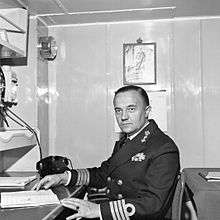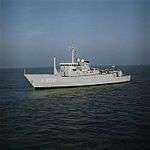Royal Netherlands Navy Submarine Service
The Royal Netherlands Navy Submarine Service (Onderzeedienst) is a department of the Royal Netherlands Navy that is responsible for deploying Dutch submarines. It was set up on 21 December 1906, out of the Torpedo Service, and merged with the Mine Service on 15 July 2005.
History

The submarine service was established on December 21, 1906. In this year the Royal Netherlands Navy commissioned its first submarine, the HNLMS O 1. The Submarine Service was tasked with taking care of the equipment of the submarines and the training of the crews. At this time there were still doubts about the usefulness of submarines. Royal Netherlands Navy Officers do indeed see an "interesting and ingeniously constructed mechanism in the vessel," but they are hesitant about their practicality. Trial sailing slowly but surely removed the doubts in the naval command. But only under the influence of the First World War did the officers get more interested in the new type of war material.[1]
During the First World War and the Inter-war period the Royal Netherlands Navy ordered and built many submarines. As a result at the start of the Second World War the Royal Netherlands Navy Submarine Service had more than 20 submarines at its disposal.[1] On 10 May 1940 the Royal Netherlands Navy had three operational submarines in the Netherlands, namely the HNLMS O 9, O 10 and O 13.[2] The O 11 was being repaired, while O 8 and O 12 were undergoing maintenance. Meanwhile, O 14 and O 15 were active at the time in the Caribbean. Furthermore, seven submarines were in various stages of completion at different yards.[2] On the other hand, the Dutch navy had 15 operational submarines in the Dutch East Indies.[3] These submarines played an important role during the war, by confronting and sinking enemy ships. For example, HNLMS O 16 and K XVII sunk several Japanese ships in 1941.[4] However, there were also losses in this theater, both HNLMS O 16 and K XVII were sunk in December 1941.[4]
After 1945 the Submarine Service had eight submarines, but due to intensive use in the war these were in a bad condition.[1] Also the fact that the fleet consisted of different classes was a problem. It made maintenance and exercise of crews very pricey. Due to the economic malaise and the high costs caused by operations in 'the East', there was no money left for new construction. In other words, the future of the service did not look rosy. In the end the navy managed to take four submarines on loan from the British and the Americans. In 1946 the Netherlands still had a total of eight operational submarines in service; HNLMS O 21, O 23, O 24, O 27, Dolfijn, Zwaardvisch, Zeehond and Tijgerhaai.[5] Since the home port at Den Helder was in ruins, these submarines were for the time being using the Waalhaven in Rotterdam as their base.[5] For the Submarine Service this period just after the Second World War meant depending on Dutch pre-war submarines and second-hand British and American submarines. The commissioning of the Dolfijn-class between 1960-1965 were thus in all respects an important milestone. The four boats formed the backbone of the Dutch Submarine Service during a large part of the Cold War; they were in service from 1960 to 1992.[6]
The Dutch submarine fleet never reached the size it had before the Second World War again.[1] The new global power relations also generated a new package of tasks. In cooperation with other NATO countries, these are mainly non-attack tasks. Since the Dutch submarines were ideally suited for unnoticed explorations, the Royal Netherlands Navy Submarine Service was mostly focused on gathering intelligence during the Cold War. This happened, for example, during the New Guinea crisis (early 1960s), when three Dutch submarines patroled the Indonesian ports, to warn against possible invasions of West New Guinea. Furthermore, in the period from 1970 to the 1990s the crew of the six Dutch submarines secretly gathered information about the Soviet Union. Most of the other missions the Submarine Service carried out remain secret to this day.[7]
Equipment
| Class | Photo | Type | Number | Dates | Details |
|---|---|---|---|---|---|
| Walrus class | _in_2008.jpg) | Submarine | 4 | 1994 | Multi-purpose Diesel-electric powered hunter-killer submarines for Deep Ocean Operations and Brown Water & Special Force Operations. SLEP 2015–2017, will be replaced by 4 new subs from 2025 onwards. |
| Mercuur class |  |
Submarine Support Vessel | 1 | 1987 | Submarine Support Vessel & MCM Command, upgraded in 2017. |
Facts
Here is a list with some facts about the Royal Netherlands Navy Submarine Service:[8]
- All Dutch submarines built after 1940 bear the name of a marine mammal.
- A total of 56 submarines have been in the service of the Royal Netherlands Navy
- It is a tradition that your shoes are thrown overboard on your last trip
- The Dutch submarine service is one of the few submarine services where everyone has his or her own bunk. The crew does not suffer from the "hot bunk" situation (meaning when two crewmen spell shifts on the same bunk), as is the case with the American and German submarines.
Known Commanders
- Piet de Jong
- Anton Bussemaker
- Carel Adrianus Johannes van Well Groeneveld
- Hendrikus Abraham Waldemar Goossens
See also
References
- Peter van der Hoest (20 September 2006). "Een eeuw onderzeeboten". www.maritiemnederland.com. Retrieved 10 May 2018.
- de Bles, Boven and Homburg, pp. 95
- de Bles, Boven and Homburg, pp. 99
- van Royen, p.7
- de Bles, Boven and Homburg, pp. 101
- "Driecilinder onderzeeboten". www.marineschepen.nl. 7 May 2018. Retrieved 10 May 2018.
- Raymond Boere (17 June 2017). "Nederlandse onderzeeërs bespioneerden de Russen". www.ad.nl. Retrieved 10 May 2018.
- "De onderzeedienst: wist je dat … ?". www.veteraneninstituut.nl. Retrieved 10 May 2018.
Bibliography
- Karreman, Jaime (2017). Spionage-operaties van Nederlandse onderzeeboten van 1968 tot 1991. Amsterdam: BWV Media. ISBN 978-90-826995-0-0.
- Anten, Jaap (2011). Navalisme nekt onderzeeboot: de invloed van internationale zeestrategieën op de Nederlandse zeestrategie voor de defensie van Nederlands-Indië, 1912-1942. Amsterdam: Pallas Publications/ Amsterdam University press. ISBN 9789048514359.
- de Bles, Harry; Boven, Graddy; Homburg, Leon (2006). Onderzeeboten!. Zaltbommel/Den Helder: Aprilis/Marinemuseum. ISBN 9059941306.
- van Royen, P.C. (1997). Hr.Ms. K XVII en Hr.Ms. O 16: De ondergang van twee Nederlandse onderzeeboten in de Zuid-Chinese Zee (1941). Amsterdam: Van Soeren. ISBN 90-6881-075-8.
- Beers, A.C. van (1945). Periscoop op! De oorlogsgeschiedenis van den onderzeedienst der koninklijke marine. Amsterdam: Scheffer en Sikkema.
- Jalhay, P.C.; Wijn, J.J.A. (1997). Ik nader ongezien! De onderzeeboten van de Koninklijke Marine. Amsterdam: De Bataafsche Leeuw. ISBN 9067074624.
- Schoonoord, D.C.L. (2012). Pugno Pro Patria: De Koninklijke Marine tijdens de Koude Oorlog. Steenwijk: Van Wijnen-Franeker.
- Bezemer, K.W.L. (1987). Zij vochten op de zeven zeeën. Houten. ISBN 9789026920455.